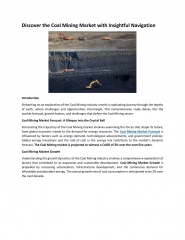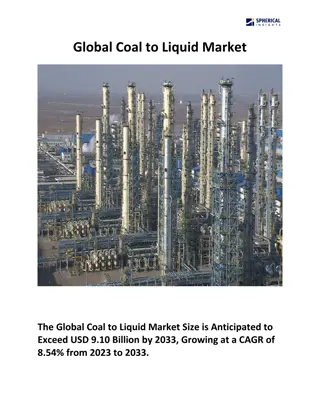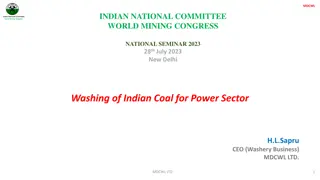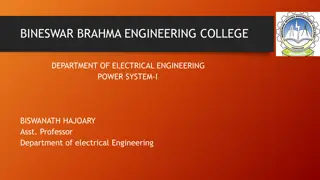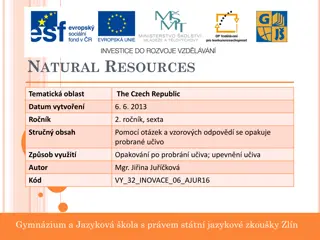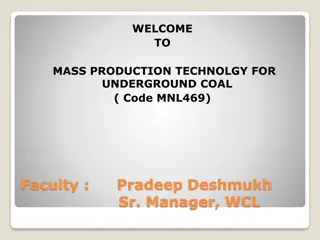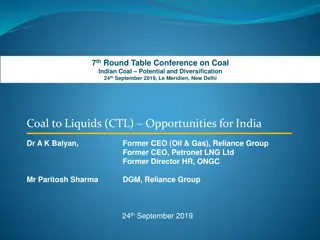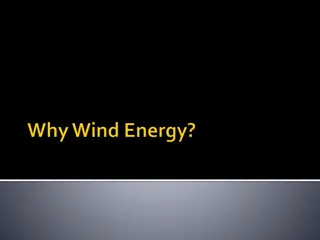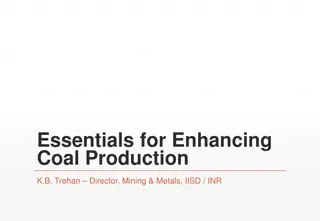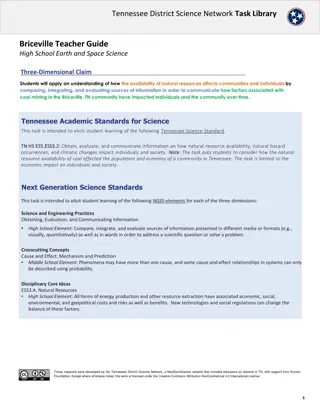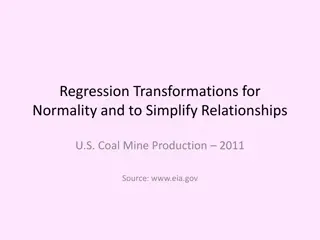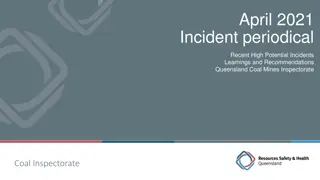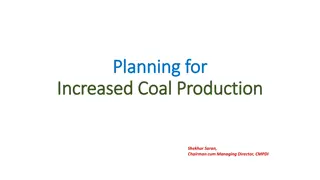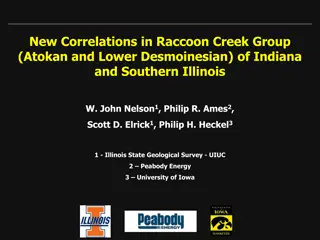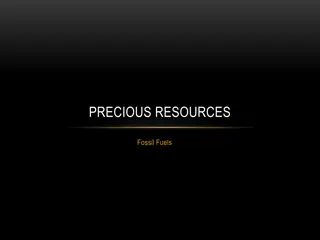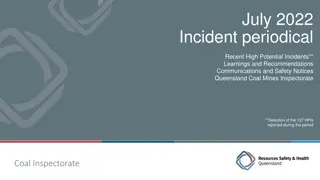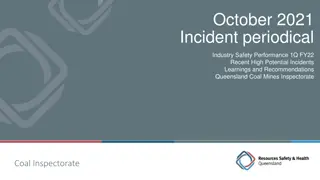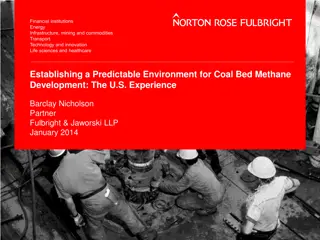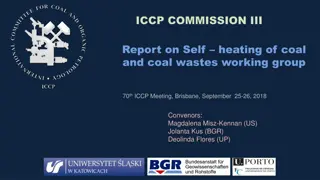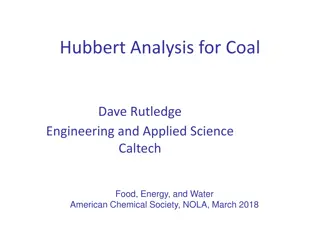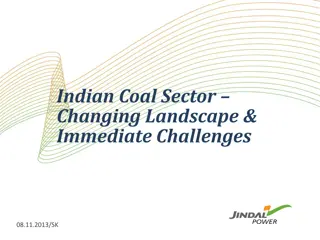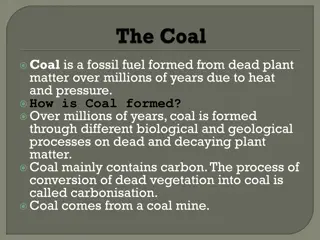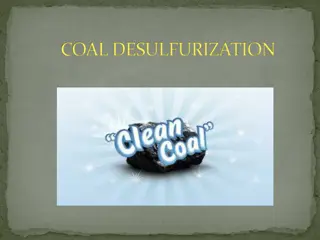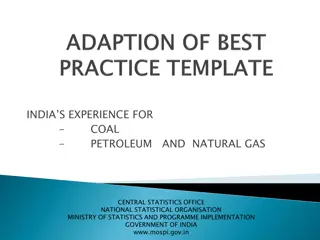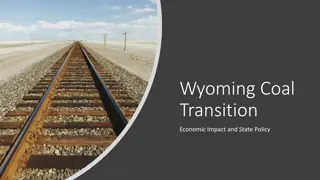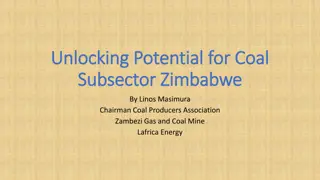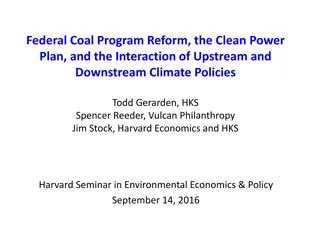Discover the Coal Mining Market with insightful navigation
Our report explores Coal Mining Market Growth in great detail to offer valuable insights for surviving in a dynamic sector. By looking at the latest trends and opportunities for growth we help businesses make informed decisions within the Coal Mining Market.
3 views • 3 slides
Analysis and Modelling of Specific Energy Consumption in Thermal Power Plants
This analysis focuses on the specific energy consumption for the transportation of coal ash slurries in thermal power plants using Computational Fluid Dynamics (CFD). The study emphasizes the efficiency factor in energy consumption and its impact on the national economic engine. It also discusses th
1 views • 27 slides
Improving Heat Rate Efficiency at Illinois Coal-Fired Power Plants
Heat rate improvements at coal-fired power plants in Illinois are crucial for enhancing energy conversion efficiency, reducing carbon intensity, and minimizing pollution. By increasing the heat rate/efficiency by 6%, these plants can generate more electricity while burning the same amount of coal. T
2 views • 11 slides
Analyzing Laurie Lee's Language in Describing Coal Tips
Laurie Lee's use of language to describe the coal tips is analyzed in this text. Emphasis is placed on identifying descriptions starting from paragraph 6 onwards, highlighting the effectiveness of chosen words and phrases in creating vivid imagery and conveying emotions to the reader.
0 views • 38 slides
EU Coal Regions Exchange: Pitch Presentation Guidelines for Matchmaking Session
In the upcoming matchmaking session on December 10th, 2021, representatives from EU coal regions will have the opportunity to pitch their ideas for potential exchanges and engage in discussions. Participants are required to prepare a formal pitch slide by December 6th, stick to a strict 90-second ti
0 views • 4 slides
Global Coal to Liquid Market
\"The Global Coal to Liquid Market Size is Anticipated to Exceed USD 9.10 Billion by 2033, Growing at a CAGR of 8.54% from 2023 to 2033. \n\n\"\n
0 views • 5 slides
Overview of Indian Coal Washing for Power Sector: MDCWL National Seminar 2023
Indian coal industry aims for significant growth with production targets set for FY 2030. The abundance of coal resources in India, especially non-coking coal, plays a crucial role in the country's power generation. With a focus on enhancing the quality of coal through washing processes, the sector
0 views • 9 slides
Overview of Power Systems and Energy Generation
The power system encompasses generation, distribution, and transmission systems that convert various forms of energy, such as coal and diesel, into electrical energy. Energy cannot be created or destroyed but can only be transformed from one form to another. Generation involves converting primary en
3 views • 30 slides
Understanding Fly Ash in Coal-Fired Power Plants
Fly ash is a by-product material generated from coal combustion in power plants. It is a waste material that needs proper disposal or recycling. The chemical composition of fly ash includes Silicon Dioxide, Calcium Oxide, Iron Oxide, and Aluminum Oxide, among others. ASTM C618 defines two classes of
0 views • 30 slides
Natural Resources and Mineral Deposits in the Czech Republic
The Czech Republic's natural resources include renewable sources like sun energy and water, as well as non-renewable resources such as mineral deposits and fuels like black coal and oil. The country has rich non-metal deposits and varied metal deposits. Mineral deposits are abundant, with significan
0 views • 8 slides
Update on Federal Regulation for Coal Ash Users in Texas
A comprehensive update on the Federal Regulation for Coal Ash Users in Texas provided by the American Coal Ash Association. The update covers key aspects such as the background of the regulation, exemptions for beneficial uses, examples of deficiencies, expected litigations, and the latest legislati
0 views • 12 slides
Advancing Energy Research in Appalachia through ARIES Initiative
The Appalachian Research Initiative for Environmental Science (ARIES) led by Dr. John R. Craynon emphasizes the importance of science-based approaches in energy projects. ARIES focuses on areas like coal mining, natural gas, electricity generation, and renewables, with a strong emphasis on coal mini
0 views • 44 slides
Mass Production Technology for Indian Coal Sector
India's coal production sector, led by nationalized and private companies, faces the challenge of meeting growing demand. With significant proven coal reserves, the focus is on increasing production efficiency through mass production technology. The syllabus emphasizes techniques for continuous mini
0 views • 54 slides
Exploring Coal-to-Liquid Technology for Energy Security in India
India's abundant coal reserves present opportunities for utilizing Coal-to-Liquid (CTL) technology to convert coal into liquid hydrocarbons. The CTL process, proven and popular globally, offers a potential solution for energy security and reducing dependence on oil imports. Despite past challenges w
0 views • 12 slides
Wind Energy: A Sustainable Alternative to Coal Generation
Wind energy emerges as a competitive and environmentally friendly alternative to coal generation, offering numerous advantages such as reduced health costs, lower emissions of pollutants like sulfur dioxide and mercury, and potential smart grid integration. The Department of Energy envisions wind en
0 views • 8 slides
British Coal Staff Superannuation Scheme Annual General Meeting Overview
The annual general meeting of the British Coal Staff Superannuation Scheme held in Edinburgh covered important updates on funding, investment, key statistics, and the 2021 actuarial valuation results. Discussions included the Scheme's primary funding aim, increased market volatility, and the challen
0 views • 23 slides
Strategies for Enhancing Coal Production: Insights and Recommendations
Enhancing coal production requires a multi-faceted approach including expanding reserves, focusing on productivity, expediting clearances, ensuring equipment approvals, implementing high-capacity mining essentials, adopting international best practices, avoiding regulatory overkill, and investing in
0 views • 19 slides
Understanding the Impact of Coal Mining on Communities: Briceville Case Study
This task challenges high school students to explore how the availability of natural resources, specifically coal, has affected the Briceville, TN community economically and socially over time. By comparing and evaluating various sources of information, students will communicate the impacts on indiv
0 views • 12 slides
Regression Transformations for Normality and Simplification of Relationships in U.S. Coal Mine Production 2011
The study analyzes Coal Mine Production data from 2011, focusing on predictor variables like Labor Effort, Surface Mine status, and regional factors. An initial regression model with interactions is presented, but residual plots indicate the need for transformation. The Box-Cox transformation is emp
0 views • 13 slides
Recent High-Potential Incidents and Recommendations in Queensland Coal Mines
The Queensland Coal Mines Inspectorate has reported several serious accidents and high-potential incidents, including injuries, equipment failures, and near-miss collisions. Recommendations include auditing safety controls, enhancing training for mobile plant operators, and ensuring compliance with
0 views • 15 slides
Enhancing Coal Production Strategy in India
India's energy landscape heavily relies on coal, with significant contributions to energy consumption and electricity generation. The country aims to increase coal production by exploring and proving new reserves. With targeted enhancements in coal-bearing areas and reserves, the coal sector in Indi
0 views • 24 slides
Insight Report: Coal Industry Update and Market Trends
This report provides an update on the coal industry, focusing on topics such as US coal production, demand, impact of mild winter, natural gas inventories and prices, coal inventories, domestic and international coal prices. It also includes price trends for different types of coal products. The inf
0 views • 10 slides
New Correlations in Raccoon Creek Group of Indiana and Southern Illinois
New insights into Middle Pennsylvanian stratigraphy in Indiana and Southern Illinois have been uncovered through extensive investigations of coal mines, borehole records, and conodont studies. Key findings include the identification of regionally continuous formations like the Stonefort Limestone an
0 views • 25 slides
Unveiling the World of Fossil Fuels: Coal Formation and Usage
Exploring the formation of fossil fuels, particularly coal, from ancient plant remains buried under the Earth's surface over millions of years. Learn about the transformation process from peat to brown and black coal, and how coal is utilized as a valuable fuel source for electricity generation and
0 views • 16 slides
EU Coal Regions Exchange Pre-Matchmaking Session Details
The pre-matchmaking session on September 29th, 2022, allows participants to pitch ideas for exchange, discuss with representatives from EU coal regions, and learn from each other. Presenters need to prepare a slide following a specific template and stick to a strict 90-second pitch timeline. Example
0 views • 4 slides
Recent High Potential Incidents and Recommendations - Queensland Coal Mines Inspectorate
The July 2022 incident periodical by the Queensland Coal Mines Inspectorate highlights two significant incidents involving a tyre fire and a CMW crush injury. Recommendations include improving road conditions, enhancing emergency response procedures, and ensuring proper task planning and risk assess
0 views • 14 slides
Safety Performance and Recommendations in Queensland Coal Mines - October 2021 Incident Periodical
The October 2021 Incident Periodical highlights recent high-potential incidents in Queensland coal mines, including uncontrolled movements in underground mines and critical control failures. Recommendations emphasize the importance of checking critical safety components, auditing procedures for dete
0 views • 17 slides
Coal Bed Methane Development: Potential, Challenges, and Environment
Explore the potential and concerns surrounding coal bed methane (CBM) in Colombia, discussing the gas content, economic viability, technological challenges, environmental impacts, and development coordination.
0 views • 13 slides
Research Report on Self-Heating of Coal Wastes
Self-heating of coal waste poses a significant challenge globally due to various factors such as organic matter properties, moisture content, and dump compaction. The oxidation of deposited coal waste can lead to high temperatures and alterations in both organic and mineral components. A classificat
0 views • 5 slides
Analysis of Fossil Fuel Usage and Energy Production Trends
Explore the historical energy production patterns, coal's share in electricity generation, Hubbert analysis for coal, and global carbon cycle projections. Consider models for coal production and CO2 emissions in climate scenarios. Delve into the world's per-person energy production and the movement
0 views • 33 slides
Challenges and Strategies in the Indian Coal Sector
The Indian coal sector faces immediate challenges such as a shortage of coal, delays in production, and issues with infrastructure. Major issues affecting coal production include clearances, land acquisition, and coal evacuation infrastructure. To address these challenges, alternative options like C
0 views • 18 slides
Understanding the Formation and Uses of Coal
Coal, a fossil fuel formed from dead plant matter over millions of years, mainly contains carbon and is extracted through mining processes. As coal ages, its carbon content increases, leading to the production of carbon dioxide when burnt. Used as fuel for cooking, electricity production, and variou
0 views • 7 slides
Understanding Coal Desulfurization Process
Coal is a crucial energy source, especially in developing countries. However, the burning of coal releases sulfur oxides, a significant pollutant. Desulfurization methods are essential to reduce harmful emissions and protect the environment and human health. This article discusses the importance of
0 views • 21 slides
The History and Importance of Coal Mining
Discover the formation of coal millions of years ago and the different types of coal - Lignite, Bituminous, and Anthracite. Learn about the various uses of coal throughout history, such as powering steam engines and generating energy. Explore the mining process of coal, from extraction to processing
0 views • 10 slides
Energy Sector Statistics and Information in India
The Central Statistics Office and National Statistical Organisation in India provide comprehensive data on the coal, petroleum, and natural gas sectors. The aim is to meet the information needs of researchers and policymakers, covering aspects such as import/export, energy generation capacity, and e
0 views • 29 slides
Wyoming Coal Transition: Economic Impact and State Policy Overview
Wyoming's coal industry has seen a significant decline in production and employment over the years, leading to economic challenges for the state. Despite minimal action taken until recent years, Wyoming is now facing the retirement of coal plants and the need to transition towards a more sustainable
0 views • 12 slides
Unlocking Potential for Coal Subsector in Zimbabwe: Insights by Linos Masimura
Linos Masimura, Chairman of the Coal Producers Association in Zimbabwe, highlights the growth in the coal sector with more than 6 operating mines by 2023. He emphasizes the need for stable electricity supply, currency stability, policy consistency, accessible financing, fair payment terms, and acces
0 views • 6 slides
State of Coal Mining Industry from a Utility Perspective
The coal mining industry faces challenges with financial health, decreased production, and significant year-over-year declines in various regions. Top companies are responsible for a majority of coal production in the U.S. as outlined in the Energy Ventures Analysis report. The impact of factors lik
0 views • 7 slides
Federal Coal Program Reform, the Clean Power Plan, and the Interaction of Upstream and Downstream Climate Policies
The presentation delves into the Federal Coal Program Reform and the Clean Power Plan, examining the interaction of upstream and downstream climate policies. It covers topics such as U.S. coal production, federal coal leasing programs, surface and underground coal mining, and policy recommendations
0 views • 40 slides
Concerns Regarding the Reopening of Invincible Colliery Southern Extension
The presentation to the NSW Government Planning Assessment Commission outlines the proposed 8-year development plan for the Invincible Southern Extension MOD 5. Concerns include the environmental impact, quality of coal reserves, potential pollution levels, displacement of jobs, and inefficiencies c
0 views • 18 slides
